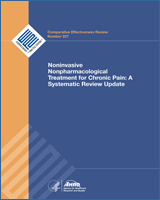From: Results

NCBI Bookshelf. A service of the National Library of Medicine, National Institutes of Health.
| Author, Year, Followup,a Pain Duration, Study Quality | Intervention | Population | Function and Pain Outcomes | Other Outcomes |
|---|---|---|---|---|
Castro-Sanchez, 2011a185 6 and 12 months Duration of pain, NR Fair | A. Myofascial Release (n=47): myofascial release (across 10 pain regions) administered by a physiotherapist; 60 minutes sessions twice weekly for 20 weeks B. Sham short-wave and ultrasound electrotherapy (n=47): both applied to the cervical, dorsal and lumbar regions using disconnected equipment; 30 minute sessions (10 minutes each region), twice weekly for 20 weeks | A vs. B Age: 55 vs. 54 years Female: NR Race: NR Mean duration of pain: NR FIQ total (0-100): 65.0 vs. 63.9 Pain (FIQ, 0-10): 9.2 vs. 8.9 Pain (VAS, 0-10): 9.1 vs. 8.9 MPQ sensory dimension (0-33): 19.3 vs. 19.9 MPQ affective dimension (0-12): 5.6 vs. 4.9 MPQ evaluative (sensory + affective) dimension (0-45): 24.9 vs. 25.3 | A vs. B 6 months FIQ Total: 58.6 vs. 64.1, p=0.048 FIQ pain: 8.5 vs. 8.0, p=0.042 VAS pain: 8.25 vs. 8.94, p=0.043 MPQ sensory: 17.3 vs. 20.7, p=0.042 MPQ affective: 4.5 vs. 5.2, p=0.042 MPQ evaluative: 21.9 vs. 26.2, p=0.022 12 months FIQ Total: 62.8 vs. 65.0, p=0.329 FIQ pain: 8.8 vs. 8.7, p=0.519 VAS pain: 8.74 vs. 8.92, p=0.306 MPQ sensory: 18.2 vs. 21.2, p=0.038 MPQ affective: 4.8 vs. 5.1, p=0.232 MPQ evaluative: 23.2 vs. 26.7, p=0.036 p-values are from authors’ ANOVAb | A vs. B 6 months Clinical Global Impression Severity Scale (Likert, 1-7): 5.3 vs. 6.0, p=0.048 Clinical Global Impression Improvement Scale (Likert, 1-7): 5.6 vs. 6.3, p=0.046 12 months Clinical Global Impression Severity Scale: 5.5 vs. 6.2 p=0.147 Clinical Global Impression Improvement Scale: 5.8 vs. 6.5, p=0.049 p-values are from authors’ ANOVAb |
Castro-Sanchez, 2011b186 1 and 6 months Duration of pain, NR Poor | A. Massage-Myofascial Release (n=32): Massage-Myofascial release therapy (across 18 pain regions) administered by a physiotherapist; weekly 90-minute session for 20 weeks. B. Sham magnotherapy (n=32): weekly 30-minute session of disconnected magnotherapy (applied on cervical and lumbar area for 15 minutes each) for 20 weeks. | A vs. B Age: 49 vs. 46 years Female: 94% vs. 96% Race: NR Mean duration of pain: NR | A vs. B 1 month VAS painc: 8.4 vs. 9.4, p<0.043 6 months p-values are from authors’ ANOVAb | A vs. B 1 month STAI state anxiety (20-80)c: 21.5 vs. 22, p=NS STAI trait anxiety (20-80)c: 25.1 vs. 26.3, p=NS BDI (0-63)c: 2.1 vs. 2.5, p=NS SF-36 physical function (0-100): 46.8 vs. 49.6, p=0.049 SF-36 physical role (0-100): 24.6 vs. 29.0, p=0.047 SF-36 bodily pain (0-100): 75.1 vs. 89.9, p=0.046 SF-36 general health (0-100): 66.8 vs. 68.4, p=0.093 SF-36 vitality (0-100): 61.6 vs. 59.2, p=0.055 SF-36 social function (0-100): 60.6 vs. 63.6, p=0.081 SF-36 emotional role (0-100): 50.5 vs. 47.0, p=0.057 SF-36 mental health (0-100): 75.0 vs. 78.3, p=0.082 PSQI, sleep duration, p=0.041d: patients with severe problems, 60% vs. 83%; moderate problems, 37% vs. 10%; and no problems, 3% vs. 7% 6 months STAI state anxietyc: 22.0 vs. 23.0, p=NS STAI trait anxietyc: 25.8 vs. 26.2, p=NS SF-36 physical function: 48.2 vs. 51.2, p=0.281 SF-36 physical role: 25.5 vs. 27.5, p=0.213 SF-36 body pain: 75.6 vs. 77.8, p=0.293 SF-36 general health: 67.5 vs. 68.1, p=0.401 SF-36 vitality: 62.2 vs. 58.9, p=0.312 SF-36 social function: 61.3 vs. 63.9, p=0.088 SF-36 emotional role: 49.1 vs. 46.9, p=0.219 SF-36 mental health: 76.5 vs. 80.0, p=0.126 PSQI, sleep duration, p=0.047d: patients with severe problems, 57% vs. 93%; moderate problems, 37% vs. 0%; and no problems, 7% vs. 7% p-values are from authors’ ANOVAb |
ANOVA = repeated-measures analysis of variance; BDI = Beck Depression Inventory; FIQ = Fibromyalgia Impact Questionnaire; MPQ = McGill Pain Questionnaire; NR = not reported; NS = not statistically significant; PSQI = Pittsburgh sleep quality index; SF-36 = Short-Form 36 health questionnaire; STAI = State-Trait Anxiety Inventory; VAS = visual analog scale
Unless otherwise noted, followup time is calculated from the end of the treatment period
Changes in scores were analyzed by using a 2 (groups: experimental and placebo) X 4 (time points: baseline, immediately postintervention, at 1 and 6 months) repeated-measures analysis of variance
Values estimated from figures in the article.
For all other dimensions of the PSQI (subjective sleep quality, sleep latency, habitual sleep efficiency, sleep disturbance, daily dysfunction), there were no statistically significant difference between groups in the proportion of patients experiencing severe, moderate or no problems in the authors’ analysis of variance (ANOVA).
From: Results

NCBI Bookshelf. A service of the National Library of Medicine, National Institutes of Health.